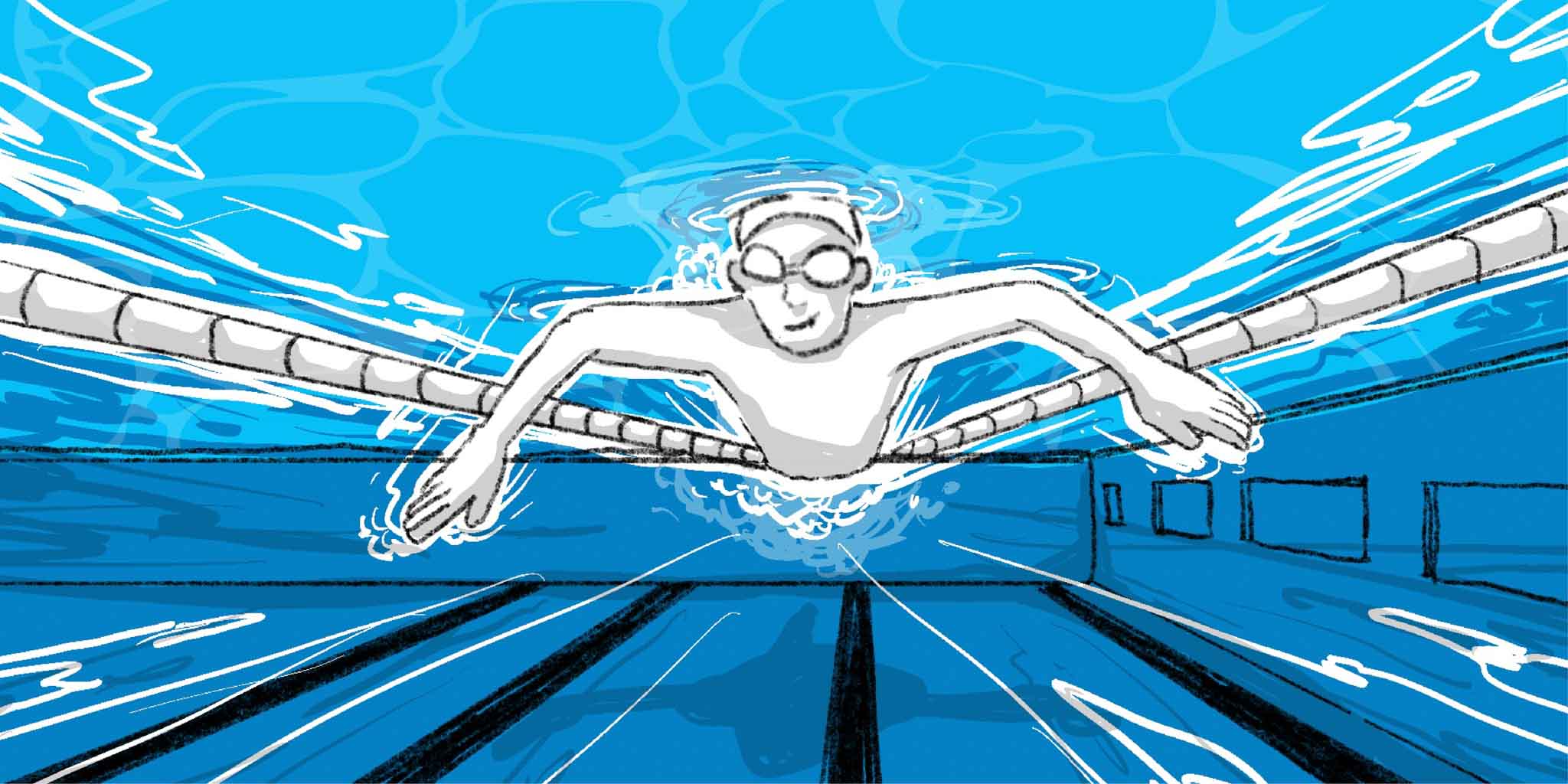Understanding The Forward Start (Competition Starter)

Competitions like the freestyle, breaststroke, and butterfly get off to a “forward start” from the blocks. Coaches allot time to teach the forward start in the weeks before a competition because most swimmers who enroll in masters swim programs have little or no experience swimming competitively.
Many swimmers have learned and improved their off-the-block starts using the below teaching progression. Take your time with each of these processes, allowing yourself to become accustomed to them before going on to the next. Always practice your starts in water at least 6 feet (2 meters) deep.
1. Simplify. You must first review the streamlined body position to dive from the starting blocks into the water. Create a straight body line on the pool deck to start. Squeeze your thumb of the top hand around the thumb of the bottom hand and squeeze your ears between your biceps as you place one hand over the other. You can align your spine by pulling your chin away from your chest, tightening your abs and buttocks, and bringing your feet together. Lay down on the deck with your toes pointing to hone your streamlining further.
2. Dive the pool deck. Practice diving from the side of the pool while keeping your body in a streamlined stance. Imagine a single hole made by your fingertips that would allow your entire body to enter the water. Imagine floating through a hula hoop in the water without touching the sides. As your confidence increases, move the imaginary hula hoop further away from you. If your goggles leak or slip off, tighten them. Avoid the desire to glance up as you enter the water, as this increases your frontal resistance and slows your progress. Keep your hands together, streamline your body, and make sure your neck and head align with your spine.
3. Broad jump while standing. Put your feet almost shoulder-width apart and your toes just above the front edge of the starting blocks. Jump into the water with your feet first from the unions. Utilize your hip and leg muscles to burst off the blocks and increase your distance. To gain more momentum, swing your arms.
4. A diving swing. As in step 3, take a position at the front of the starting line and visualize a hula hoop on the water before you. When you dive from the block, swing your arms up, forward, and around to build momentum. Your fingertips should pierce the center of the hoop. Keep your body sleek and taut as it passes through the center of the hypothetical hoop following your fingertips.
5. Change from a swinging plunge to an explosive breakout. Maintain your underwater streamlined position until the breakout, which is the change from the underwater phase of a start or turn to full-stroke swimming, to build on the swinging dive. When executed correctly, this changeover will maintain the start’s momentum or smoothly transition into the stroke’s rhythm. This post’s later sections will go into more information about breakout execution.
Take your place. In this step, swimmers become more accustomed to the beginning procedure and how to set up on the starting block while they wait for the starter’s directions.
The track starts, which has a staggered foot position similar to the typical start in a track meet, is the forward start most masters swimmers prefer. This start is popular among adult swimmers since it is quick, suited for people with limited flexibility, and more stable. Although the track start is advised for beginning swimmers, seasoned swimmers who prefer the traditional grab start frequently choose not to switch to the newer start. Swimmers who choose the grab start position both feet at the front of the block, wait for the starter’s commands, then grab the block either inside or outside of their feet.
Step onto the starting block as the referee blows the long whistle, then position yourself at the front edge with your feet almost shoulder-width apart, toes hanging over the edge, and eyes fixed down the pool. Move one foot back on the block when you hear the command “Take your mark,” stoop and hold the underside of the league with both hands.
As you pull back from the block for balance, keep your arms stiff and your elbows slightly bent. Lift the heel of your front leg just a little while bending your back at least 90 degrees. Your center of gravity should be retained over the ball of your front foot as you draw your weight forward with your shoulders and arms. Do not lay your chest on your legs while keeping your head lowered.
Swimmers will adjust this track start position to account for less flexibility or individual preference. If swimmers place their rear foot further back on the block and lower their hips, they may be better able to grab the block if they have restricted flexibility in their back and hamstring muscles.
Others prefer to keep their hands free to start the relay conventionally by not grabbing the block. In addition, many swimmers like to maintain a neutral weight position or lean back slightly while maintaining weight over the back foot.
Take the time to become accustomed to bringing one foot back, coming down, and holding your start position for at least two seconds as you learn the forward start. Find a foot and hand position that is comfortable for you by experimenting with them.
7. Go! Pulling your body slightly forward with the block’s underside as the starting beep starts will cause your center of gravity to change over the water. Push with your legs as your body unfolds over the water and achieves a streamlined stance as you feel yourself falling forward. Imagine your entire body falling through a little airtight tube and landing in the middle of your fictitious hula hoop.
To become familiar with your starting technique, you must practice the entire sequence, from the starting commands to the breakout. Review the progression’s steps before starting your practice gently. Add additional force to your leg drive as you get more at ease, or push off the blocks and picture yourself bursting as you move out of the starting position.
3 Drills to Improve Your Forward Start
Try these engaging drills for diversity and to improve your freestyle, breaststroke, and butterfly forward starts for competition.
Clapping Exercise
Stand on the pool deck with your hands at your sides and clap for a coach or a swimming companion. When you hear the clap, instantly move your hands and arms into a streamlined position. When repeated consistently, this drill can help you improve your reaction time.
Drill with One Leg
This starting drill is meant to enhance leg power and is ideal for swimmers with strong stability and are familiar with the track start. It is performed from the starting blocks. Assume your starting posture on the block and remove your back foot. When you hear the starting command, begin with your front leg only.
Jumping over a pole
Request that a coach or a swim buddy hold a maintenance or shepherd’s hook safety pole in front of the starting block for you to dive over as you do your start. The greater the distance between the pole and the block, the more leg strength is required to clear it. Similarly, raising or lowering the pole causes you to shift your body position to clear the bar. The pole adjustments are designed to achieve a clean entry into the water with little frontal resistance.


